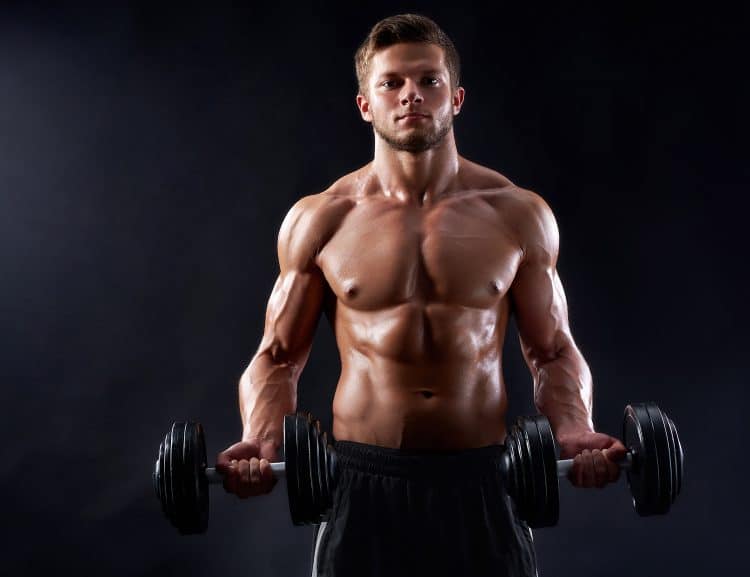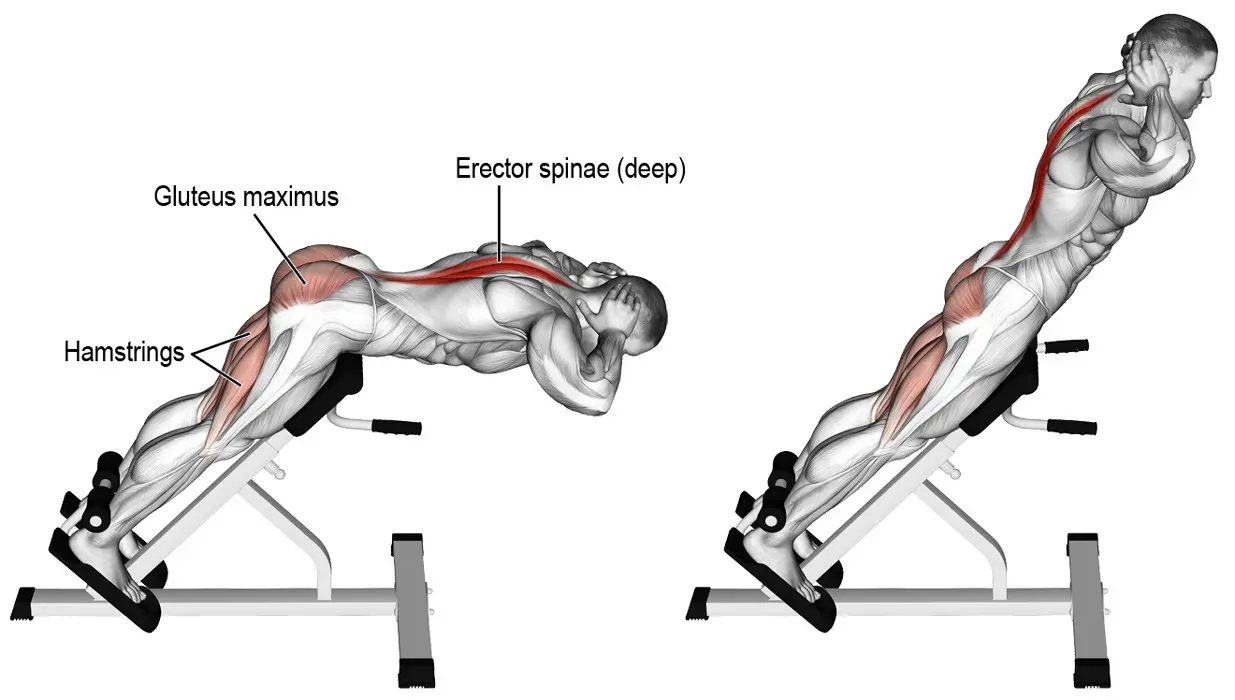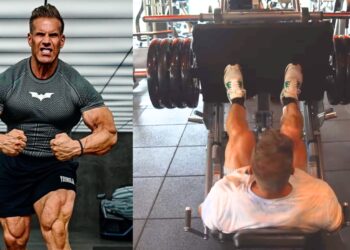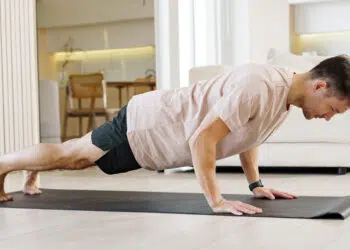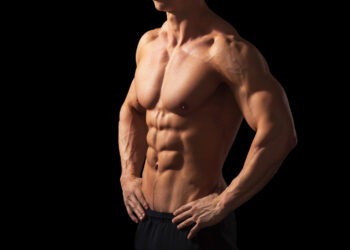When I started working in gyms (over 30 years ago!!!), the fitness industry was in its infancy. In fact, it was barely an industry at all. Personal training had yet to become a recognized job, and social media didn’t exist. There were no “fitness personalities” or influencers. It was a much simpler time.
As a result, exercisers tended to learn by doing. They begin by doing basic, usually full-body workout programs and gradually progressed from there. Most new gym users were given an induction program, during which they learned how to do things like barbell squats, deadlifts, bench presses, overhead presses, and other compound staples of strength training.
In many ways, this was the ideal scenario. There was less information overload, and if you wanted to learn more about training, you had to buy books or magazines, which also helped control the flow of information. As a result, exercisers were much more likely to follow programs that were right for their abilities and experience, rather than hop on the newest trend or fad workout.
Nowadays, if you are a beginner looking for training information, you’re much more likely to end up reading material written by some insta-expert trying to promote advanced training methods.
So, instead of “earning your wings” with a couple of years mastering the basics, you end up following a workout that would bring a Mr. Olympia contender to their knees. While super-advanced workouts do make for great articles, especially when accompanied by some artful photos, they can cause much more harm than good.
After all, if you have never been for a run before, you wouldn’t follow an Olympic marathon runner’s workout plan. And yet, with strength training, that’s often what happens. Following workouts that are too advanced too soon often leads to injuries, disillusionment, and exercise drop-out. It’s no wonder that a lot of beginners start training only to quit a couple of weeks later.
Level Up Your Fitness: Join our 💪 strong community in Fitness Volt Newsletter. Get daily inspiration, expert-backed workouts, nutrition tips, the latest in strength sports, and the support you need to reach your goals. Subscribe for free!
This article is the antidote to all those overly advanced training programs. Instead, it’s for beginners looking to “get toned” and dip their toes in the wonderful world of strength training, which, after all, is one of the most valuable types of exercise you can do.
What is Muscle Tone?
Muscle tone means different things to different people. From a physiological standpoint, muscle tone is the amount of tension in a relaxed muscle. It’s basically a muscle’s readiness to contract (1).
A muscle can be hypotonic, which means it lacks tone and is inhibited in some way. Or, a muscle can be hypertonic, which means it’s too tense and may also be tight.
Physical therapists and other soft-tissue specialists check the tone of muscles by palpating them, which means using their fingers to press into the surface of a muscle. With practice, a well-trained therapist will be able to say whether a muscle is hypotonic, hypertonic, or if the level of tone is just right.
In a lot of cases, exercise can fix hypotonicity, and stretching and massage will alleviate hypertonicity. Healthy muscles are neither hypertonic nor hypotonic.
In workout terms, tone refers to the appearance of a muscle. It should look firm, and there should also be a reasonable level of definition. In other words, the outline of the muscle is visible. People who are toned look fit and athletic.
There is a big difference between being toned and being ripped like a bodybuilder, and a lot of exercisers only want to achieve the former.
Getting toned usually involves a combination of strength training, LISS and/or HIIT cardio, and a healthy diet. It’s something that a large percentage of exercisers should be able to achieve. The good news is that getting into shape and looking toned will usually improve the physiological definition of muscle tone.
Muscle Tone Workout Plan – Phase One
Assuming you are new to training with weights, the best place to start for most people is whole-body workouts. Whole-body workouts make good use of your training time and mean you only need to hit the gym 2-3 times a week.
This provides plenty of time for things like cardio, stretching, rest, and recovery. It also means you don’t have to commit too much time to working out. After all, this is all relatively new to you.
Do the following workout two or three times a week, depending on your energy levels and the time you have available for exercise, e.g.:
- Monday
- Thursday
Or
- Monday
- Wednesday
- Friday
Continue for six weeks, gradually lifting a little more weight as you get stronger.
| Exercise | Sets | Reps | Recovery | |
| 1 | Goblet squat | 3 | 12-15 | 1-2 minutes |
| 2 | Leg curl | 3 | 12-15 | 1-2 minutes |
| 3 | Chest press | 3 | 10-12 | 1-2 minutes |
| 4 | Seated row | 3 | 10-12 | 1-2 minutes |
| 5 | Dumbbell shoulder press | 2 | 10-12 | 1-2 minutes |
| 6 | Lat pulldown | 2 | 10-12 | 1-2 minutes |
| 7 | Plank | 2 | 20-30 seconds | 1-2 minutes |
| 8 | 45-degree back extension | 2 | 10-12 | 1-2 minutes |
Program Notes:
Warm-up before each workout by doing 5-10 minutes of easy cardio followed by some dynamic stretching and mobility exercises for your major muscles and joints.
Start light and focus on perfecting your technique before worrying about how much weight you are lifting. It’s okay if your first few workouts are easy.
Cool down after each workout with a few more minutes of easy cardio followed by static stretches for the muscles you’ve just worked. This will help alleviate muscle tightness and may reduce post-exercise soreness.
Exercise Descriptions:
Get the most from the exercises in your workout by doing each one with perfect form. Not only will your results be better, but you’ll also reduce your risk of injury.
1. Goblet Squat
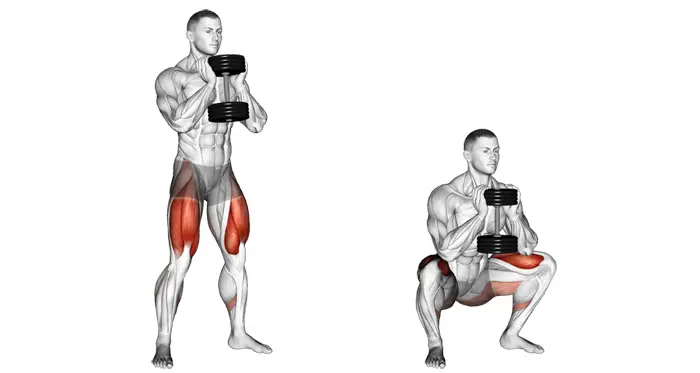
Target muscles: Quadriceps, hamstrings, glutes, abductors, adductors
Squats are arguably one of the best lower body exercises you can do. But, before you put a barbell on your back, you need to master the basic squatting movement. Goblet squats are not just a good leg exercise; they are also very useful for teaching the right way to squat safely.
Learn how to do goblet squats here.
2. Leg Curl
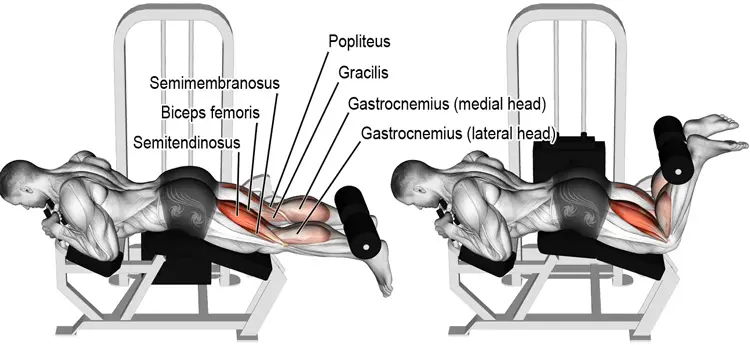
Target muscles: Hamstrings
While squats work all your lower body muscles, they tend to be quite quadriceps-dominant. Balance your leg muscle development by doing leg curls, which isolate and emphasize your hamstrings.
You can do seated hamstring curls or lying hamstring curls as preferred. They’re both similarly effective, so use whichever one your gym has got or that you like best.
3. Chest Press

Target muscles: Pectoralis major, triceps
While the bench press is arguably the most popular chest exercise, it’s not the best choice for beginners because it’s all too easy to get trapped under the barbell. The chest press machine is much more beginner-friendly.
Learn how to do chest presses here.
4. Seated Row
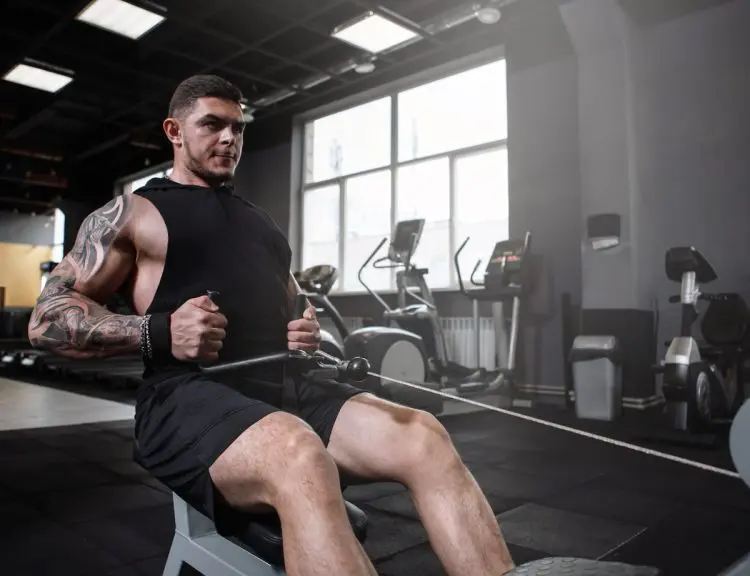
Target muscles: Latissimus dorsi, biceps
Seated rows work your upper back while teaching you to maintain an upright torso. This is a useful postural exercise that also works those all-important biceps! Make sure you stabilize your lower back by bracing your abs. Just tense them up like you are expecting to get punched in the gut.
Learn how to do seated rows here.
5. Dumbbell Shoulder Press
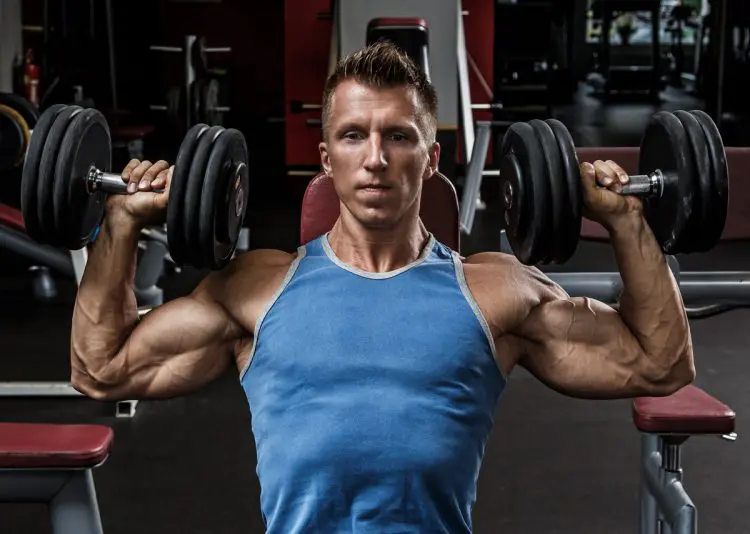
Target muscles: Deltoids, triceps
It won’t be much of a surprise to learn that dumbbell shoulder presses work your shoulders! Properly called your deltoids, your shoulders are involved indirectly in most upper body exercises, but this movement targets them more directly.
Learn how to do dumbbell shoulder presses here.
6. Lat Pulldown
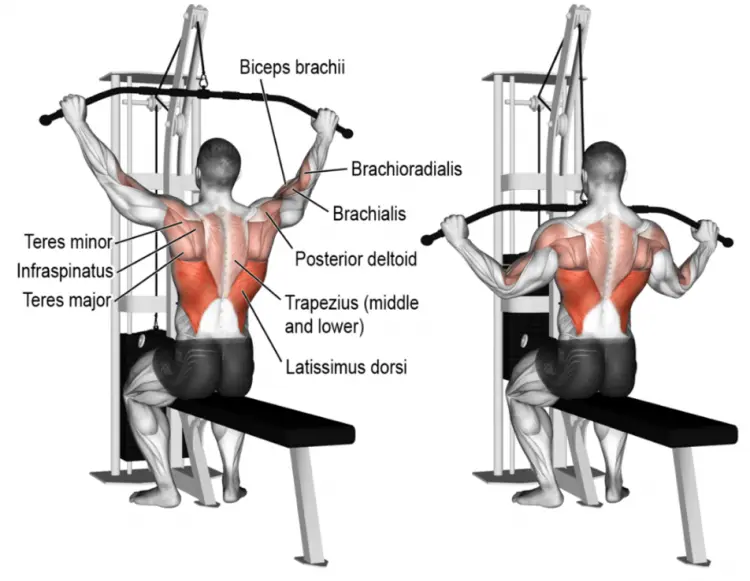
Target muscles: Latissimus dorsi, biceps
As you get stronger, you may progress to doing pull-ups and chin-ups for your upper back. But, for now, lat pulldowns will get the job done. You can do lat pulldowns using a wide, narrow, underhand, overhand, or neutral grip, but the overhand medium grip is ideal for beginners.
Learn how to do lat pulldowns here.
7. Plank
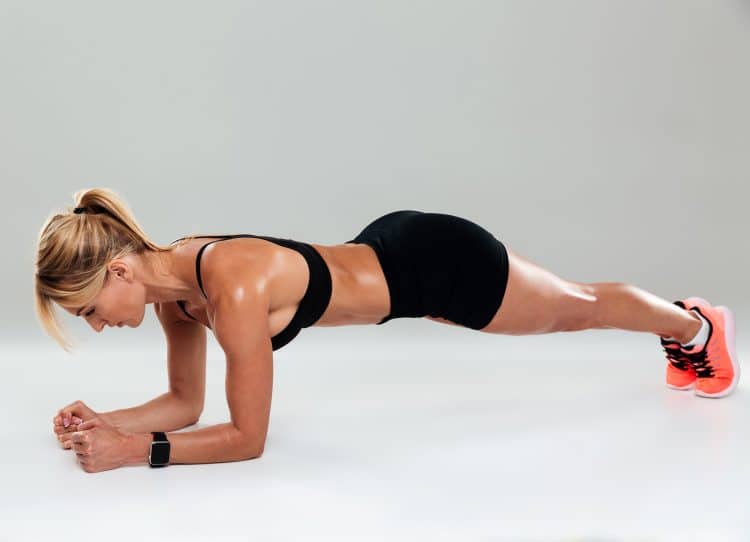
Target muscles: Core
Planks are a popular core exercise, with the core being the collective term for the muscles of your midsection, including rectus abdominis, obliques, and transverse abdominis. These muscles stabilize your lumbar spine, and the rectus abdominis is your six-pack muscle.
8. 45-Degree Back Extension
Target muscles: Erector spinae
Also known as hyperextensions, this bodyweight exercise works your lower back, glutes, and hamstrings. A strong lower back is less prone to injury and will also help you sit and stand up straighter for better posture.
Learn how to do 45-degree back extensions here.
Muscle Tone Workout Plan – Phase Two
Full-body workouts are great for beginners, and even advanced exercisers can use them too. However, doing the same type of workout over and over will eventually become boring and could hamper your progress.
So, for your next six-week phase of training, you’re going to progress to a simple upper body/lower body split, which is also called an A/B split. This allows you to do more exercises per muscle group, exposing you to a wider range of movements.
You can train three or four times a week as preferred, i.e.:
- Monday – workout A
- Wednesday – workout B
- Friday – workout A
- Monday – workout B
- Wednesday – workout A
- Friday – workout B, etc.
Or:
- Monday – workout A
- Tuesday – workout B
- Thursday – workout A
- Friday – workout B
Workout A – Lower Body
| Exercise | Sets | Reps | Recovery | |
| 1 | Barbell back squat | 3 | 12-15 | 1-2 minutes |
| 2 | Hip thrust | 3 | 12-15 | 1-2 minutes |
| 3 | Leg press | 2 | 10-12 | 1-2 minutes |
| 4 | Lunges | 2 | 10-12 | 1-2 minutes |
| 5 | Standing calf raise | 3 | 10-12 | 1-2 minutes |
| 6 | Cable crunch | 3 | 10-12 | 1-2 minutes |
| 7 | Side plank | 3 | 20-30 seconds | 1-2 minutes |
Program Notes:
Warm-up before each workout by doing 5-10 minutes of easy cardio followed by some dynamic stretching and mobility exercises for your major muscles and joints.
Start light and focus on perfecting your technique before worrying about how much weight you are lifting. It’s okay if your first few workouts are easy.
Level Up Your Fitness: Join our 💪 strong community in Fitness Volt Newsletter. Get daily inspiration, expert-backed workouts, nutrition tips, the latest in strength sports, and the support you need to reach your goals. Subscribe for free!
Cool down after each workout with a few more minutes of easy cardio followed by static stretches for the muscles you’ve just worked. This will help alleviate muscle tightness and may reduce post-exercise soreness.
Exercise Descriptions:
Get the most from the exercises in your workout by doing each one with perfect form. Not only will your results be better, but you’ll also reduce your risk of injury.
1. Barbell Back Squat
Target muscles: Quadriceps, hamstrings, glutes, abductors, adductors
After six weeks of goblet squats, you should be well and truly ready to progress onto barbell back squats. Start light, though, and build up gradually. This is an exercise with a sting in its tail!
Learn how to do barbell back squats here.
2. Hip Thrust
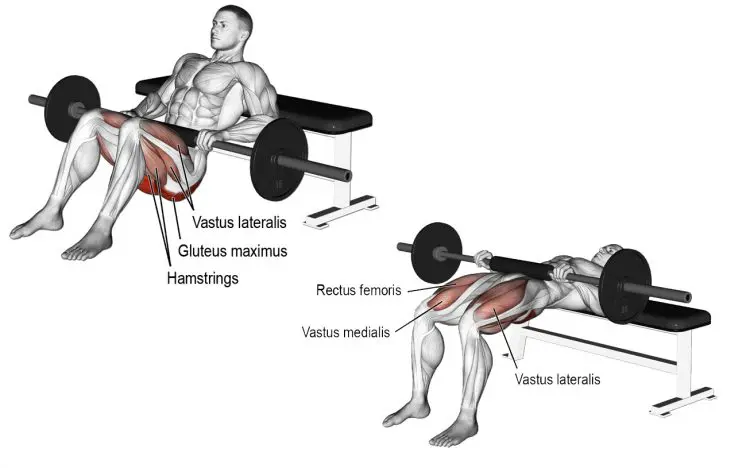
Target muscles: Hamstrings, glutes, erector spinae
Hip thrusts are the perfect partner for squats. Easier to learn than barbell deadlifts, hip thrusts work your glutes, hamstrings, and lower back, which are collectively called the posterior chain.
Learn how to do hip thrusts here.
3. Leg Press

Target muscles: Quadriceps, hamstrings, glutes
Leg presses are a valuable exercise for working your legs without overstressing your lower back. Leg press machine design and operation can vary, so ask for help if you are unsure how to use the leg press at your gym.
Learn how to do leg presses here.
4. Lunges
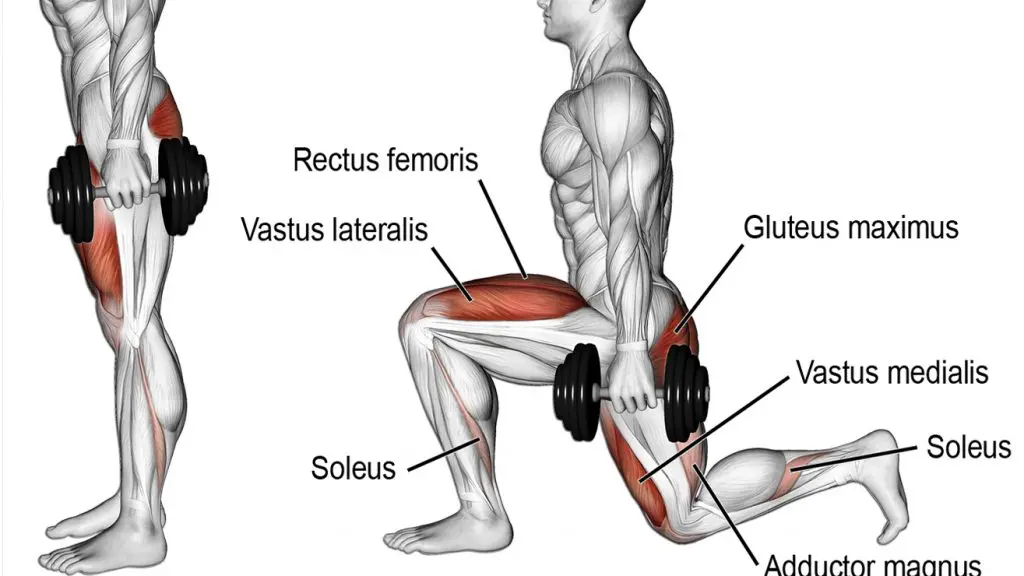
Target muscles: Quadriceps, hamstrings, glutes, abductors, adductors
Your final upper leg exercise is lunges. Done with bodyweight or light dumbbells, lunges will improve your balance and mobility while working one leg at a time. Unilateral leg exercises like lunges are helpful for identifying and fixing left to right strength imbalances.
5. Standing Calf Raise
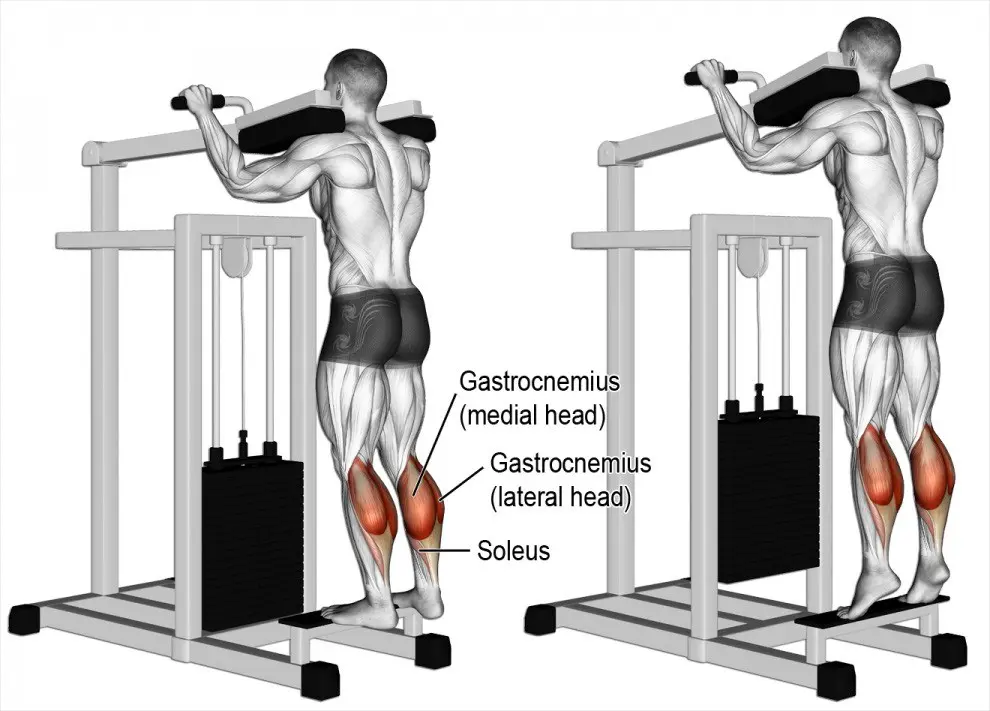
Target muscles: Gastrocnemius, soleus
Standing calf raises work your lower legs – the calves. There are two calf muscles, the larger gastrocnemius, and the smaller soleus, both of which are involved in this simple but effective exercise.
Learn how to do standing calf raises here.
6. Cable Crunch

Target muscles: Core
You’ll mostly feel cable crunches in your rectus abdominis muscle, which is located on the front of your abdomen. However, all your core muscles are involved in this straightforward but worthwhile cable machine exercise.
Learn how to do cable crunches here.
7. Side Plank
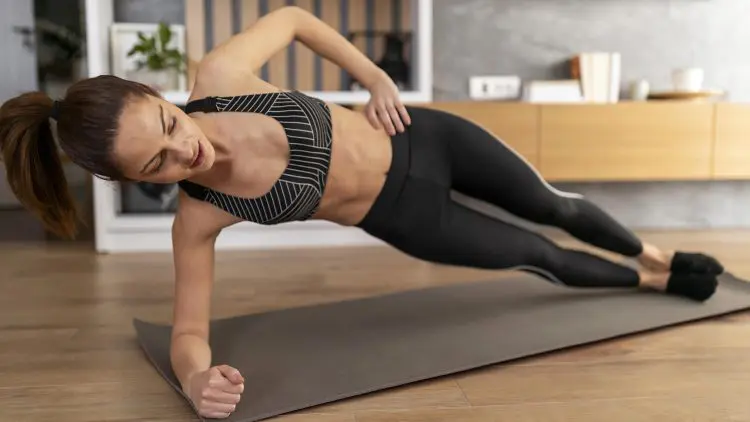
Target muscles: Core
Like front planks, side planks work your entire core, but there is a definite emphasis on your oblique or waist muscles. Working one side of your core at a time, most people find side planks a little more challenging than front planks.
How to do it:
- Lie on your side with your legs and body straight. Rest your weight on your lowermost forearm. Brace your abs.
- Lift your hips, so your body forms a straight line.
- Hold this position for the allotted time.
- Lower your hips back to the floor, turn over, and repeat on the opposite side.
Workout B – Upper Body
| Exercise | Sets | Reps | Recovery | |
| 1 | Dumbbell bench press | 3 | 10-12 | 1-2 minutes |
| 2 | Single-arm dumbbell row | 3 | 10-12 | 1-2 minutes |
| 3 | Cable crossover | 3 | 10-12 | 1-2 minutes |
| 4 | Close grip lat pulldown | 3 | 10-12 | 1-2 minutes |
| 5 | Dumbbell side raise | 3 | 10-12 | 1-2 minutes |
| 6 | EZ bar biceps curl | 2 | 10-12 | 1-2 minutes |
| 7 | Triceps pushdown | 2 | 10-12 | 1-2 minutes |
Program Notes:
Warm-up before each workout by doing 5-10 minutes of easy cardio followed by some dynamic stretching and mobility exercises for your major muscles and joints.
Start light and focus on perfecting your technique before worrying about how much weight you are lifting. It’s okay if your first few workouts are easy.
Cool down after each workout with a few more minutes of easy cardio followed by static stretches for the muscles you’ve just worked. This will help alleviate muscle tightness and may reduce post-exercise soreness.
Exercise Descriptions:
Get the most from the exercises in your workout by doing each one with perfect form. Not only will your results be better, but you’ll also reduce your risk of injury.
1. Dumbbell Bench Press
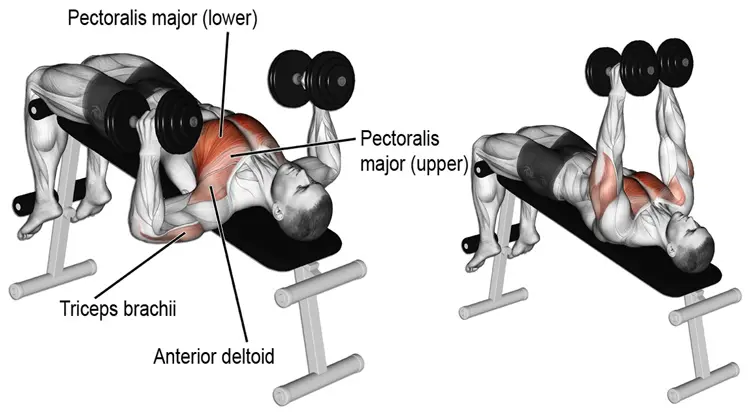
Target muscles: Pectoralis major, triceps
The dumbbell bench press is an excellent exercise for novice lifters because, if you cannot complete a rep, you can just lower the weights out and down to the floor. Because of this, it’s a safer option than barbell bench presses. However, this exercise does require balance and coordination, so don’t go too heavy too soon.
Learn how to do dumbbell bench presses here.
2. Single-Arm Dumbbell Row

Target muscles: Latissimus dorsi, biceps
Working one arm at a time, single-arm dumbbell rows leave you one arm free to support your lower back. This makes this exercise very lower-back friendly but it’s still a very effective lat and biceps builder.
Learn how to do single-arm dumbbells rows here.
3. Cable Crossover
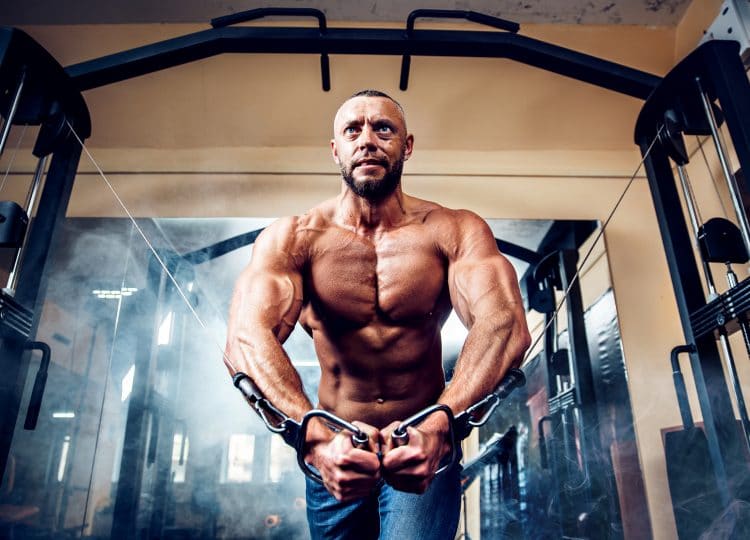
Target muscles: Pectoralis major
The cable crossover is an isolation exercise which means it works your chest without directly involving your triceps. It’s a good exercise for targeting your inner chest, especially if you keep your movements slow and smooth, really squeezing your chest at the midpoint of each rep.
Learn how to do cable crossovers here.
4. Neutral Grip Lat Pulldown
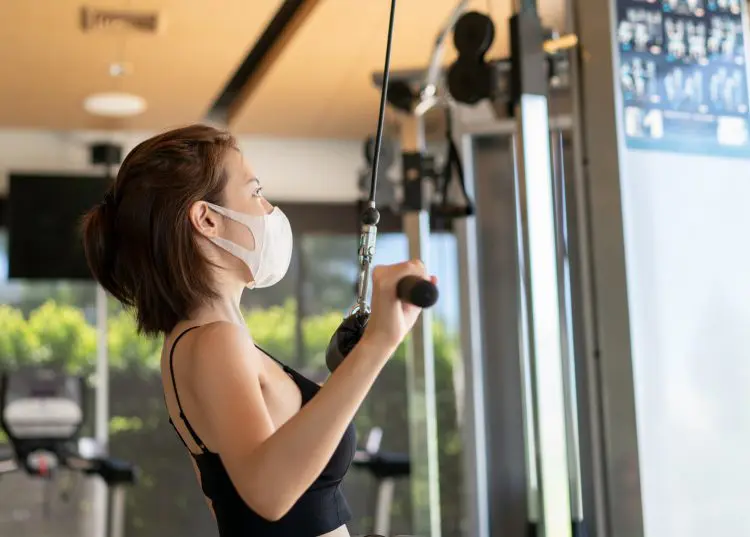
Target muscles: Latissimus dorsi, biceps
Unless you are very strong, pull-ups and chin-ups are beyond most beginners. Thankfully, you can work your back and biceps using lat pulldowns. This neutral grip option is nice alternative to the medium, overhand grip you used before.
Learn how to do neutral grip lat pulldowns here.
5. Dumbbell Side Raise
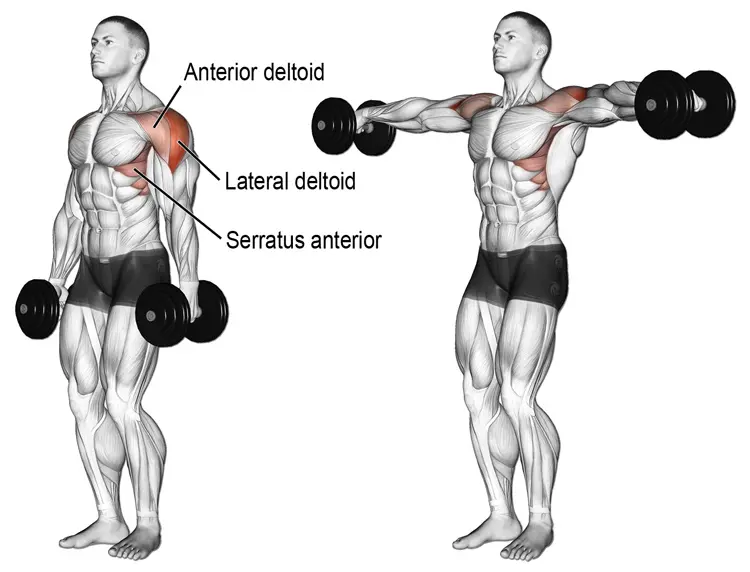
Target muscles: Deltoids
Just like cable crossovers isolate your pecs, this exercise does the same for your deltoid or shoulders. It emphasizes the medial deltoid, which is located on the side of your shoulder, which is what gives your shoulders most of their shape and width.
Learn how to do dumbbell side raises here.
6. EZ Bar Biceps Curl
Target muscles: Biceps
An EZ bar is a short barbell with bends in it that make biceps and triceps training much more wrist and elbow friendly. This exercise targets your biceps, which is the muscle on the front of your upper arm.
Learn how to do EZ bar biceps curls here.
7. Triceps Pushdown
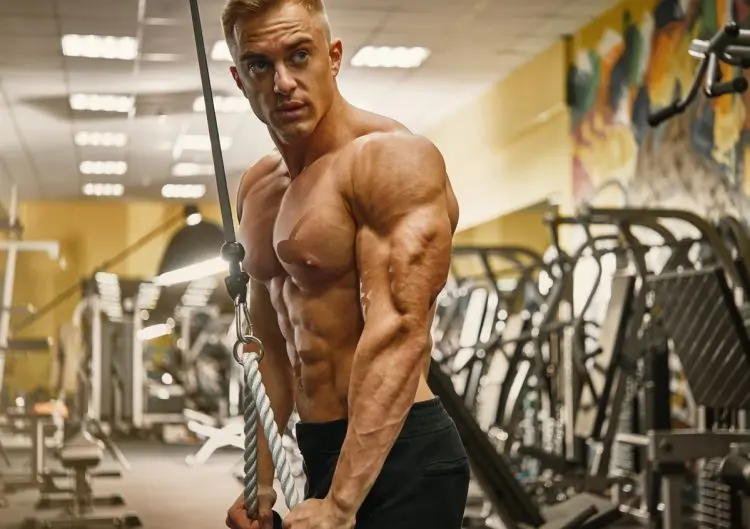
Target muscles: Triceps
Located on the back of your upper arm, the triceps straighten your elbows and opposite your biceps. Triceps pushdowns are a straightforward exercise for toning the back of your arms.
Learn how to do triceps pushdowns here.
Muscle Tone Workout Plan – Wrapping Up
After 12 weeks of consistent training, you should be able to see and feel some changes in your muscle tone. If your diet is healthy and you’ve dropped a little fat, the outline of your muscles should be emerging. Well done – you’ve done a GREAT job!
So, what comes next?
Firstly after, three months of workouts, you might benefit from a short deload. This means taking a break from training so you can regain some energy and let any accumulated aches and pains subside. This doesn’t mean you can just sit on your couch for a week. Instead, do some active recovery activities, like swimming, hiking, or cycling, so you take a break from the gym but still keep your body moving.
After that, you’ll be ready to get back in the gym and attack your next phase of training with even more energy and enthusiasm.
We’ve got hundreds of workouts in our workout database, so take a look and see which ones match your needs and goals. Remember, though, you don’t NEED to follow an advanced workout, and doing so could actually undermine your progress. After 12 weeks, you are still very much a beginner, so don’t be tempted to try an advanced-level workout just yet.
References:
1 – PubMed: Muscle Tone Physiology and Abnormalities https://www.ncbi.nlm.nih.gov/pmc/articles/PMC8071570/

